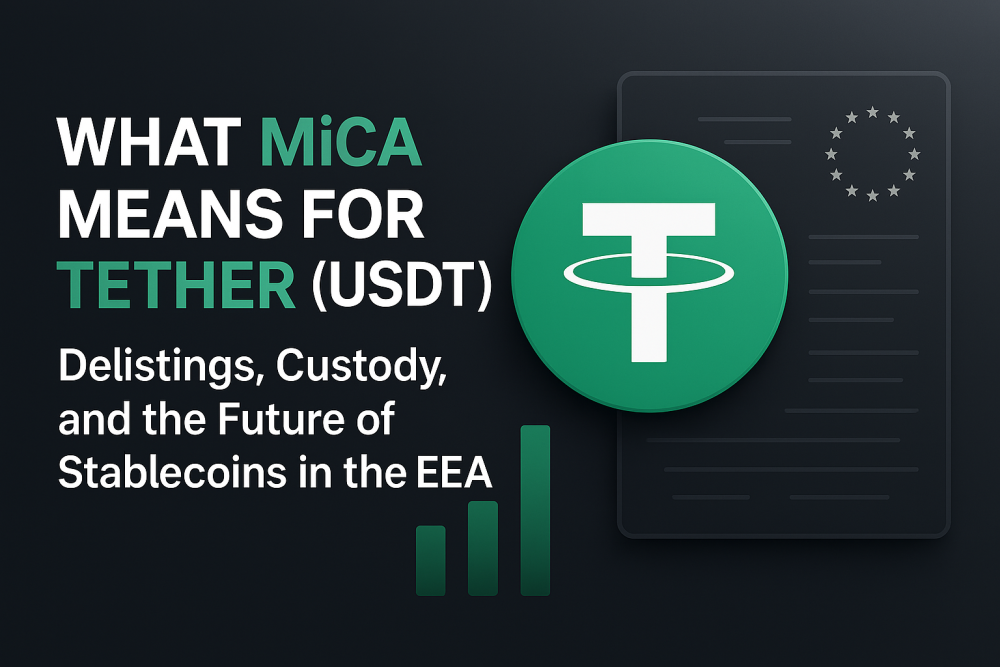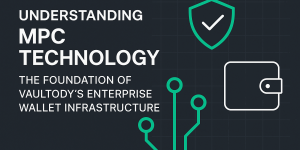What MiCA Means for Tether (USDT): Delistings, Custody, and the Future of Stablecoins in the EEA

As the European Union ushers in the new regulatory framework under the Markets in Crypto-Assets (MiCA) Regulation, stablecoins like Tether (USDT) are facing unprecedented scrutiny across the European Economic Area (EEA). Since March 31, 2025, MiCA's stablecoin rules became enforceable, triggering significant shifts in how USDT is handled by exchanges, custodians, and users. In this article, we unpack the implications of MiCA for Tether, examine which platforms have delisted USDT, explain what this means for user holdings, and share our team's view on how Vaultody and other custodians are adapting to this regulatory evolution.
What Does MiCA Say About Stablecoins Like Tether?
MiCA introduces strict requirements for issuers of asset-referenced tokens (ARTs) and e-money tokens (EMTs) within the EU. Under this regime, any stablecoin pegged to a fiat currency must be issued by a regulated entity within the EU and must receive authorization from a National Competent Authority (NCA). Tether (USDT), pegged to the US dollar, falls under the EMT category.
As of March 31, 2025, issuers of EMTs that have not received MiCA authorization are no longer permitted to offer their tokens to the public or seek admission to trading within the EEA. Importantly, the European Securities and Markets Authority (ESMA) clarified that while new offerings are prohibited, the custody and transfer of such tokens are not. ESMA stated that "custody and transfer services do not in themselves constitute an ‘offering to the public’ or ‘seeking admission to trading,’" allowing these services to continue without breaching MiCA rules.
Why Is Tether Being Delisted?
Despite being the most traded stablecoin globally, Tether has not pursued MiCA compliance. Without a licensed entity authorized to issue USDT in the EU, exchanges that are MiCA-regulated have no choice but to halt its offering. Delisting is a direct consequence of the regulatory requirement that prohibits non-compliant stablecoins from being offered to the public or listed on trading platforms in the EEA.
Tether itself has shown reluctance to conform to MiCA, going as far as discontinuing support for its euro-pegged stablecoin EUR€ in late 2024. A spokesperson for Tether stated that they would prioritize other markets until a more "risk-averse framework" is established in the EU.
Which Exchanges Have Delisted USDT?
Leading centralized exchanges took proactive measures ahead of the MiCA deadline:
- Coinbase Europe was among the earliest to delist USDT in December 2024. The move was part of broader efforts to align with MiCA.
- Crypto.com informed EU customers that it would stop offering USDT by January 31, 2025. Users were given until March 31 to convert or withdraw their holdings, after which remaining balances would be automatically converted to a MiCA-compliant asset.
- Binance announced in March 2025 the delisting of nine stablecoins, including USDT, for EEA users. Binance has discontinued spot trading pairs for USDT in the EEA, though derivatives involving USDT remain accessible due to regulatory nuances.
- Kraken placed USDT in a "sell-only" mode starting March 24, allowing users to liquidate holdings but not acquire more. Trading was fully disabled by March 31.
- OKX and Revolut followed suit earlier in the year, citing MiCA compliance as the driving force.
Decentralized exchanges, which operate outside centralized jurisdiction, have not enforced similar restrictions, meaning USDT can still be traded on-chain through DeFi protocols.
What Happens to Users' USDT Holdings?
Contrary to concerns, user holdings of USDT are not being frozen or confiscated. ESMA’s position, as reflected in guidance published earlier this year, ensures that users can continue to hold, transfer, or withdraw USDT. The distinction lies in "offering to the public," which includes listing on exchanges or actively promoting the asset.
Major exchanges like Binance and Kraken have allowed users to withdraw their USDT post-delisting. Some, like Crypto.com, took the additional step of auto-converting USDT balances after the grace period. Users are free to transfer their USDT to private wallets or custodians, although access to trading and conversions via regulated platforms is now restricted.
How Is Vaultody Handling USDT Under MiCA?
Our team previously outlined in another blog post that MiCA's wording does not prohibit custodians from safeguarding or transferring non-compliant stablecoins. This includes Tether's USDT. As such, Vaultody continues to allow clients to custody and withdraw their USDT holdings.
In light of ESMA's clarification, our team concluded that providing custody or enabling transfers of USDT does not equate to "offering it to the public." This means Vaultody clients are not impacted in terms of asset safety or access. However, new trading or acquisition of USDT via our platform is no longer supported for EEA users, in full alignment with MiCA.
Vaultody is also actively working toward full MiCA compliance and continues to communicate with regulatory bodies to ensure our platform evolves with the new legal landscape. Our focus remains on delivering secure, compliant custodial services while giving clients flexibility and control over their digital assets.
Expert Outlook on Tether's Future in Europe
Crypto legal and policy experts suggest that Tether could re-enter the EEA market if it chooses to comply with MiCA. This would require registering an entity in the EU, obtaining authorization as an e-money issuer, and adhering to reserve and transparency requirements. However, Tether has not indicated any intention of pursuing such a path.
Industry analysts note that MiCA is setting a high compliance bar, which may deter offshore stablecoin issuers from entering the EU market. Nonetheless, some see this as a positive shift toward a more secure and transparent crypto ecosystem. Circle, the issuer of USDC, is an example of a MiCA-compliant entity that has already obtained approval to offer its stablecoin within the EU.
For users and platforms in the EEA, the shift away from USDT is already underway. Exchanges are promoting MiCA-approved alternatives such as USDC or euro-backed stablecoins like EURC. The removal of USDT from compliant platforms is expected to reduce systemic risk and increase investor protection—two core goals of MiCA.
What Comes Next?
With MiCA enforcement now active, the EU has made clear that only stablecoins issued by authorized entities will be permitted in the region's regulated crypto markets. This doesn't signal the end of USDT globally, but it does reshape its role in Europe.
Vaultody will continue to monitor regulatory developments and update our service offerings accordingly. We remain committed to enabling secure, compliant access to digital assets for institutional clients and enterprise partners. While the EU market adapts to a post-USDT landscape, our platform ensures continuity and safety for those holding non-MiCA tokens.
As we move into this new era of regulated stablecoins, our team is here to support clients through the transition. Whether through secure custody of legacy assets like USDT or providing access to compliant alternatives, Vaultody remains your trusted partner in digital asset custody.




 Login
Login







 Copy link
Copy link